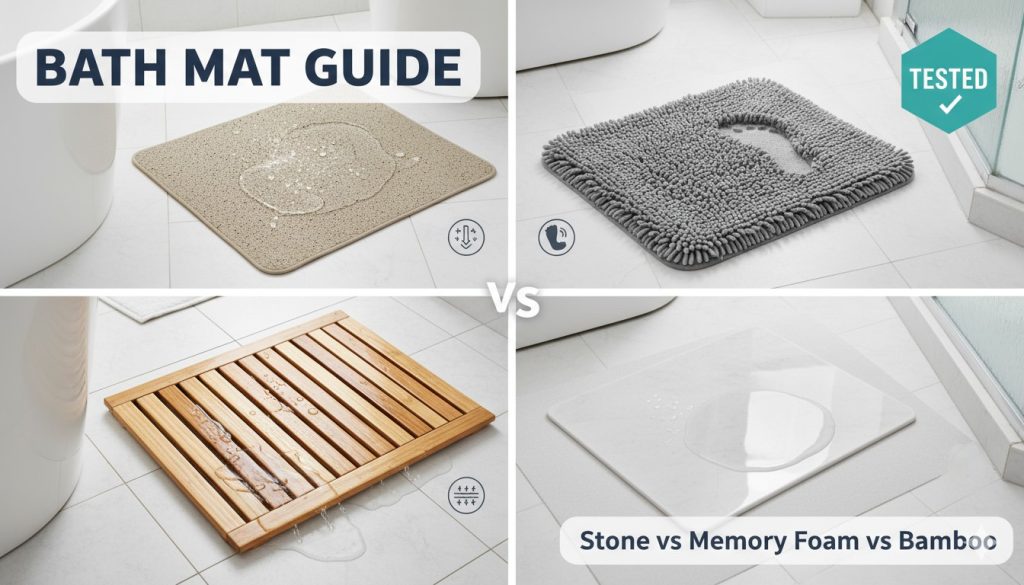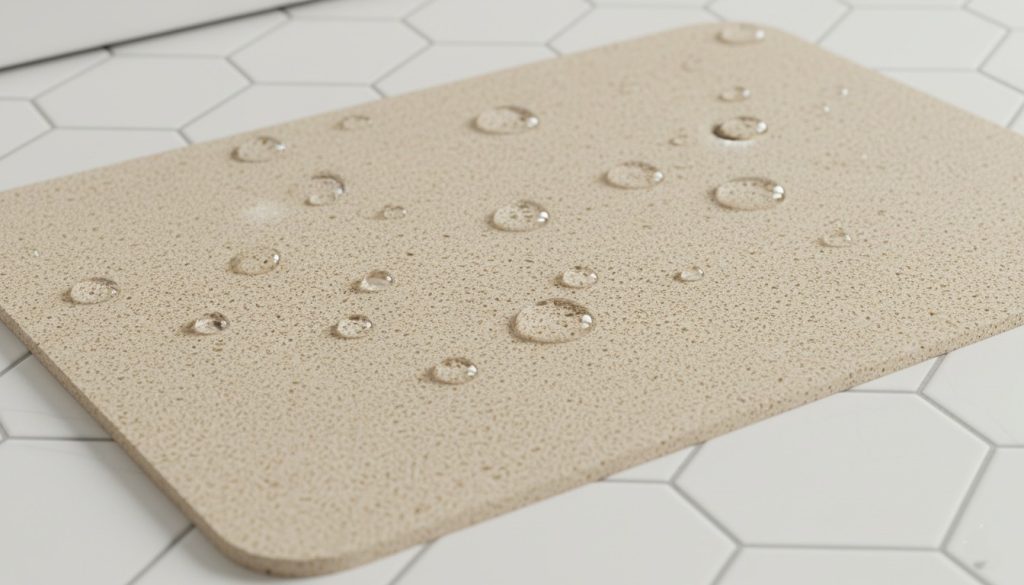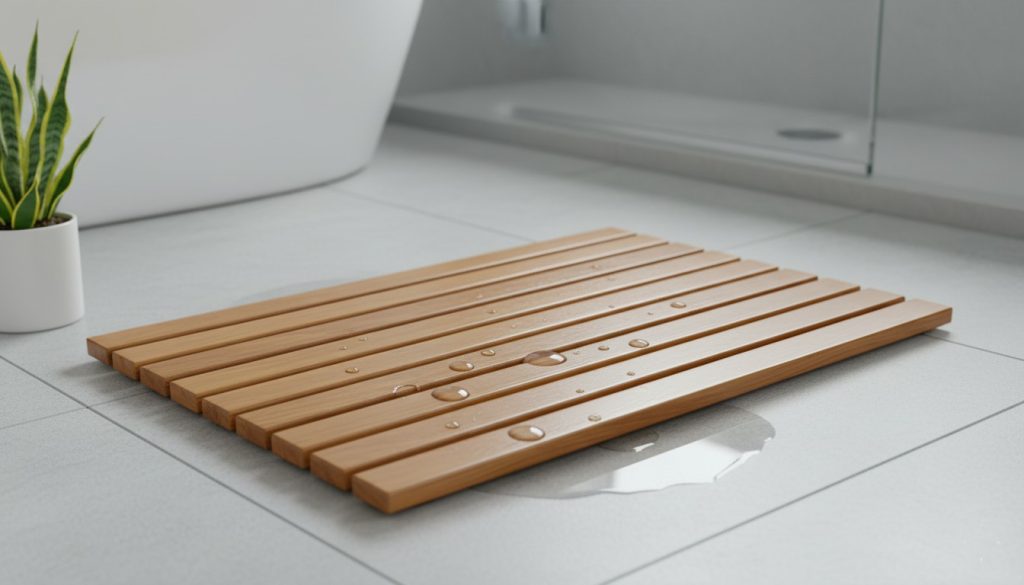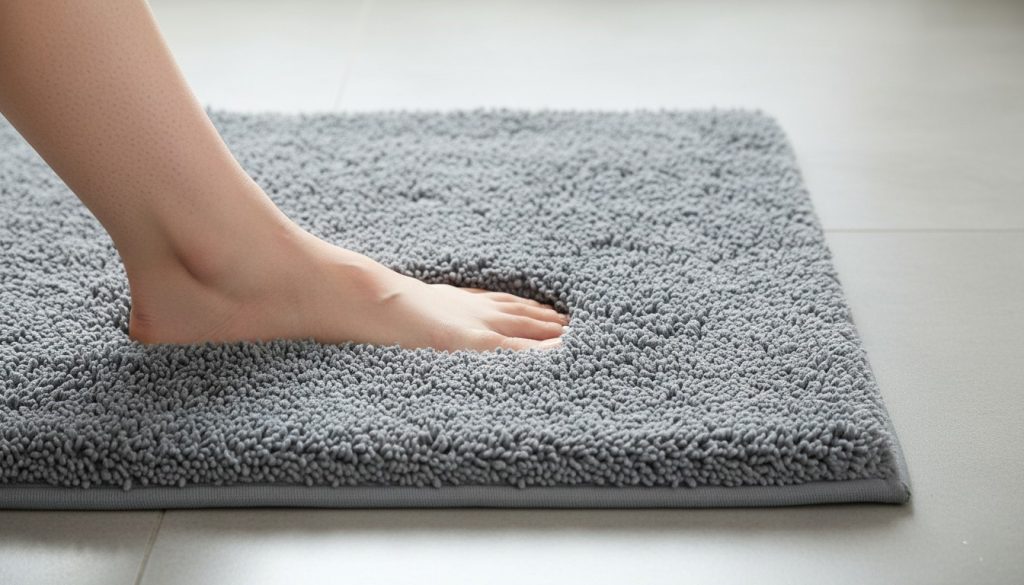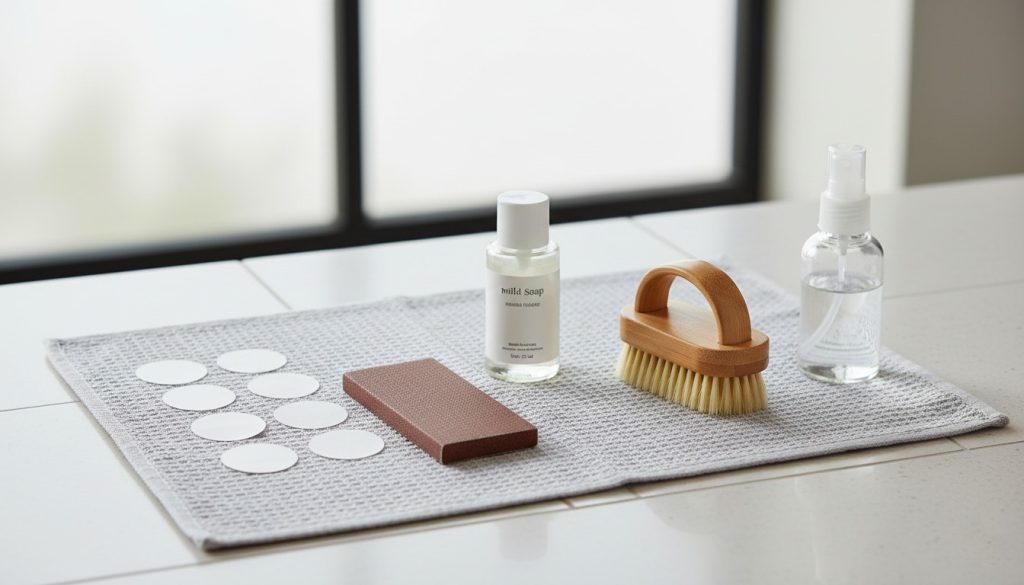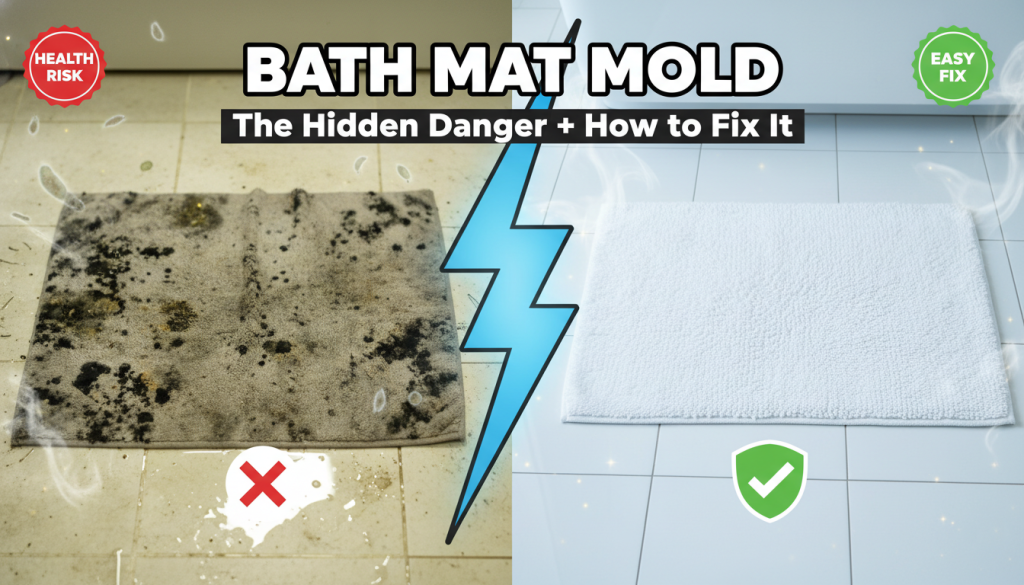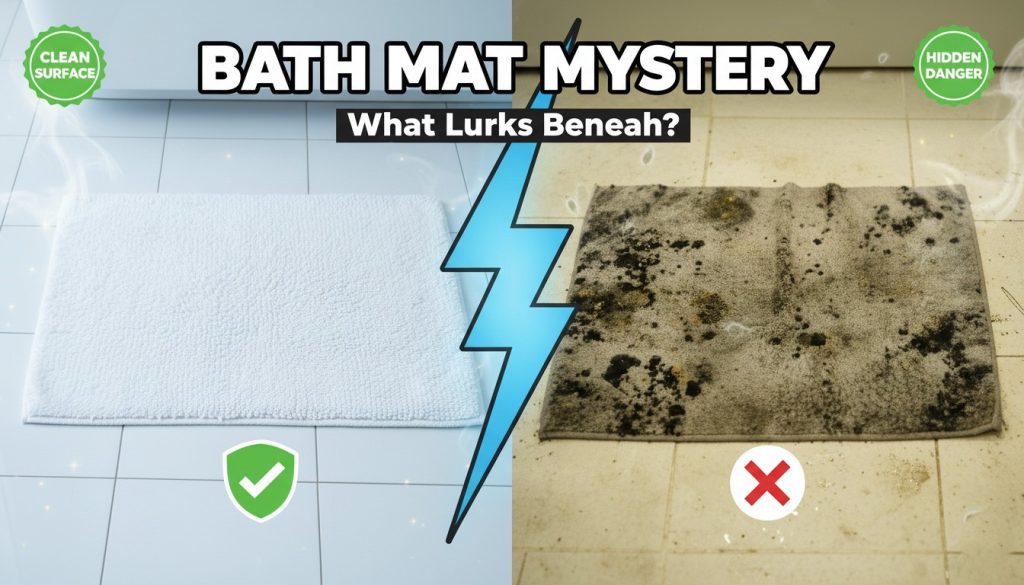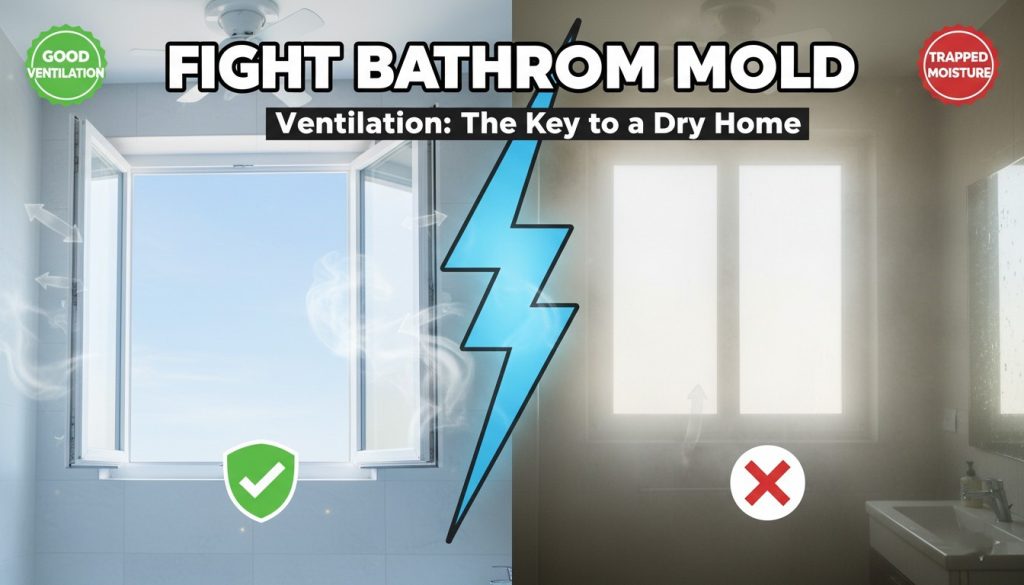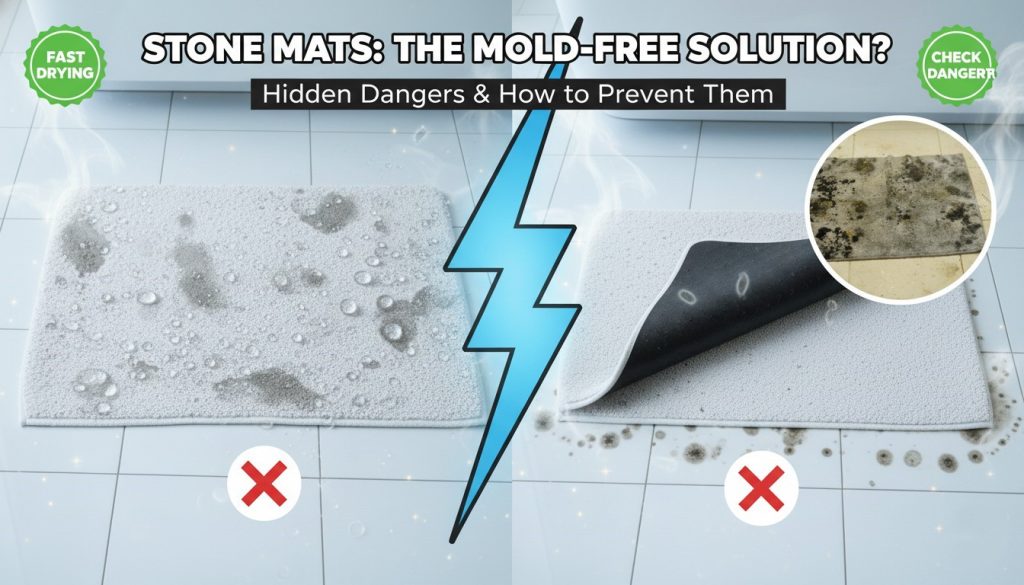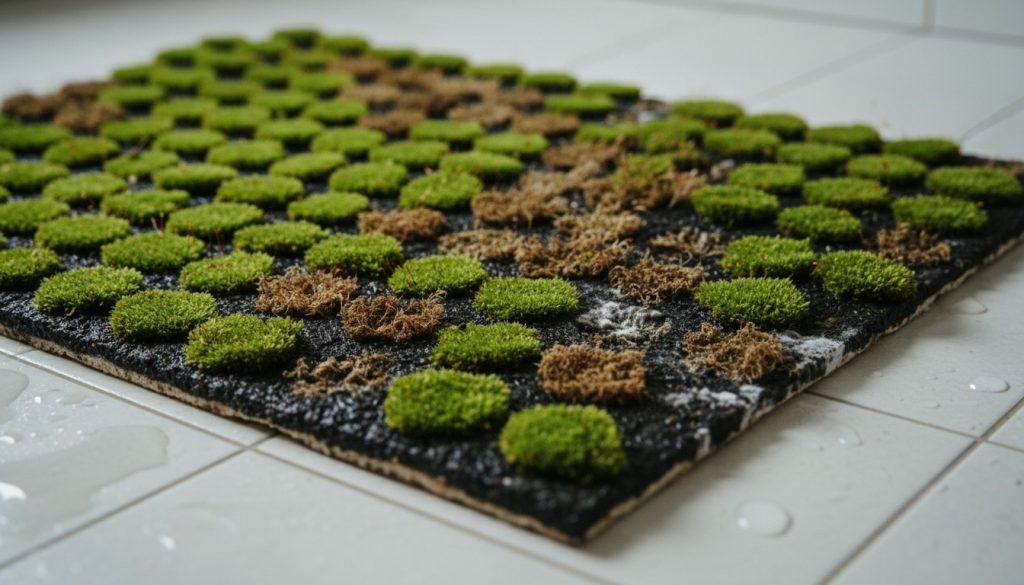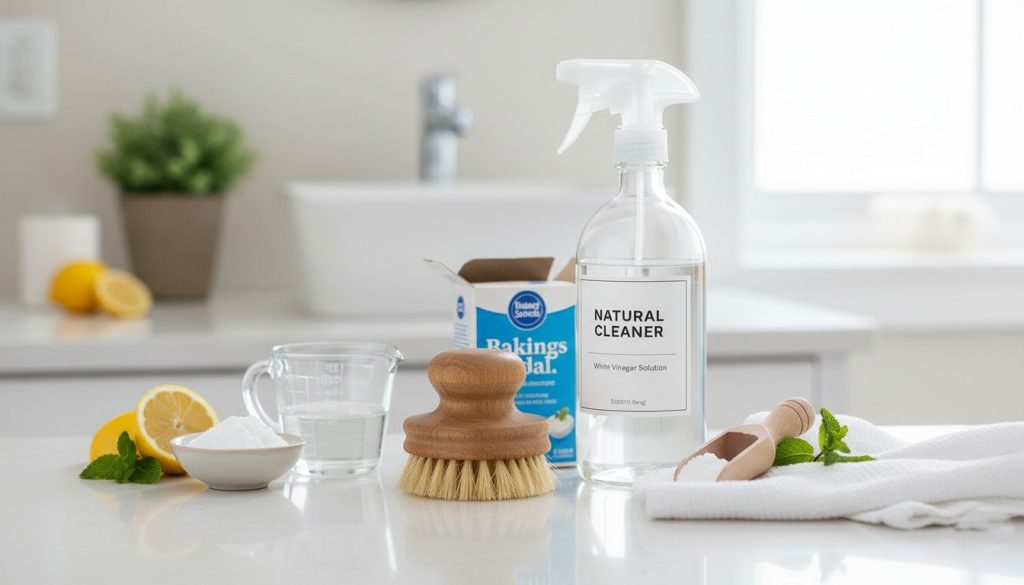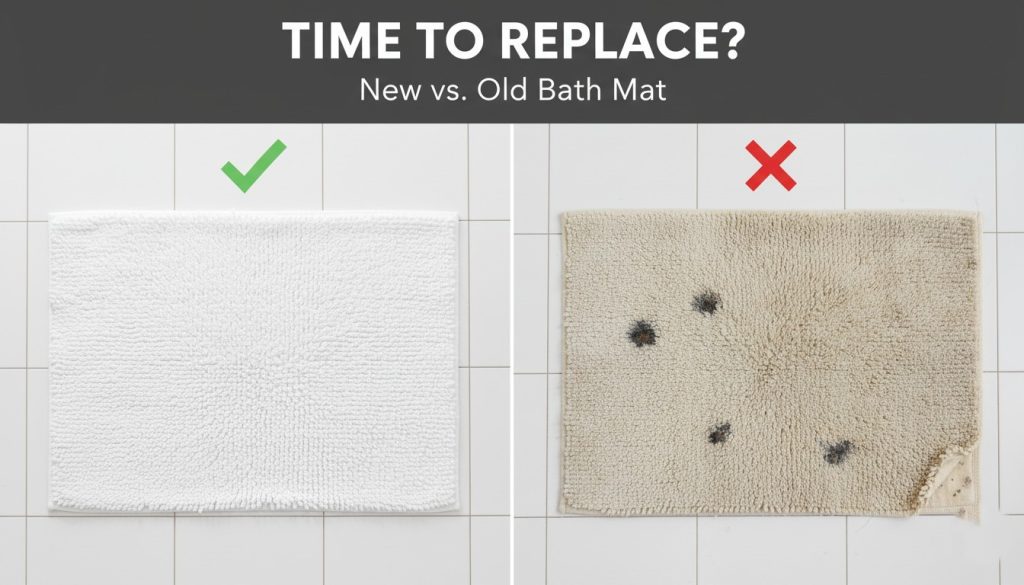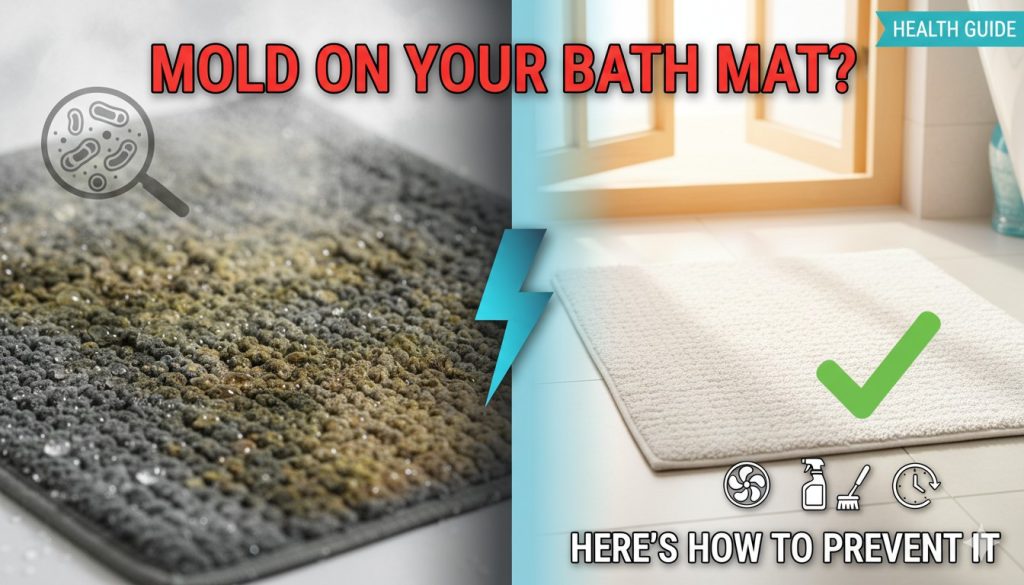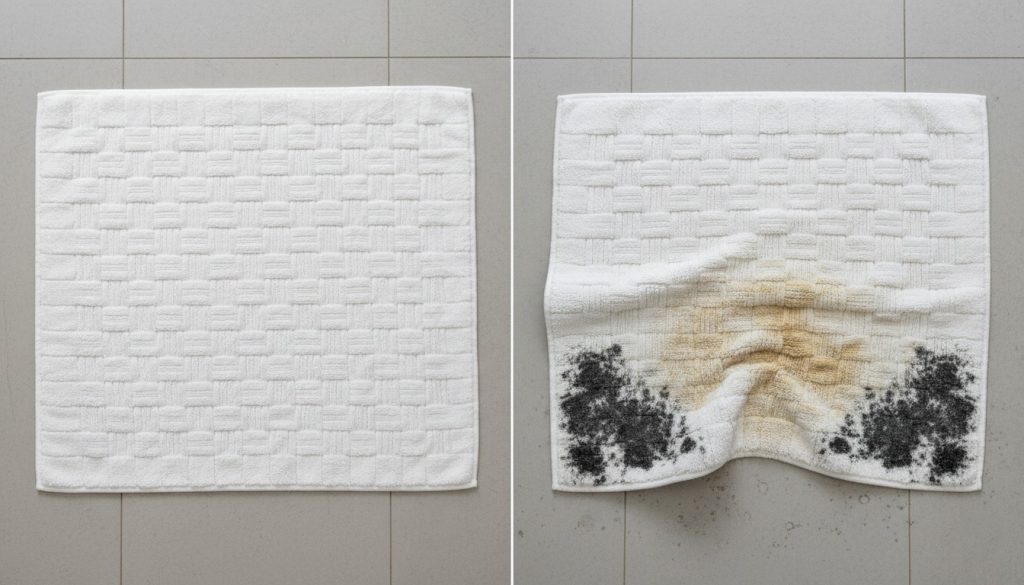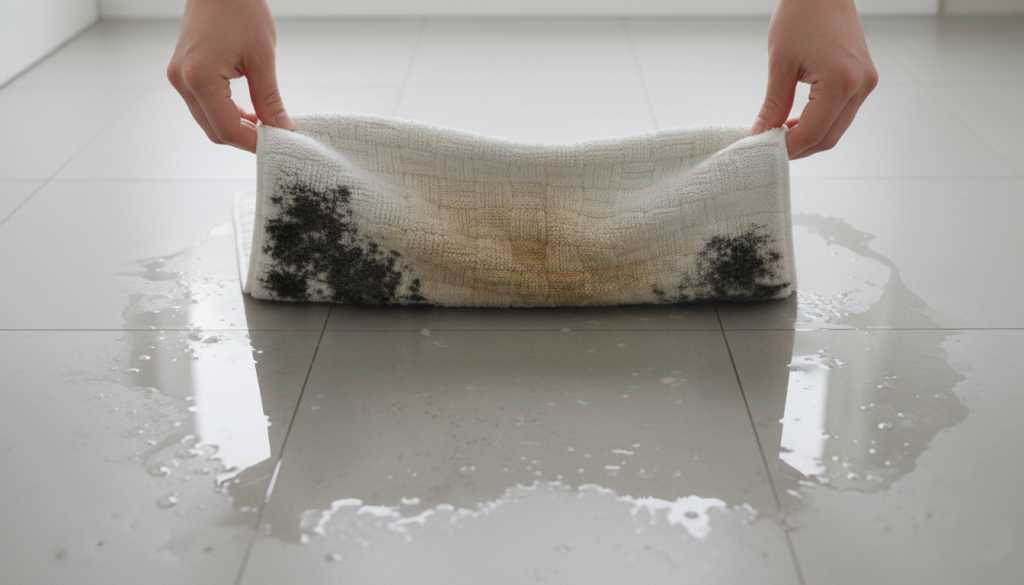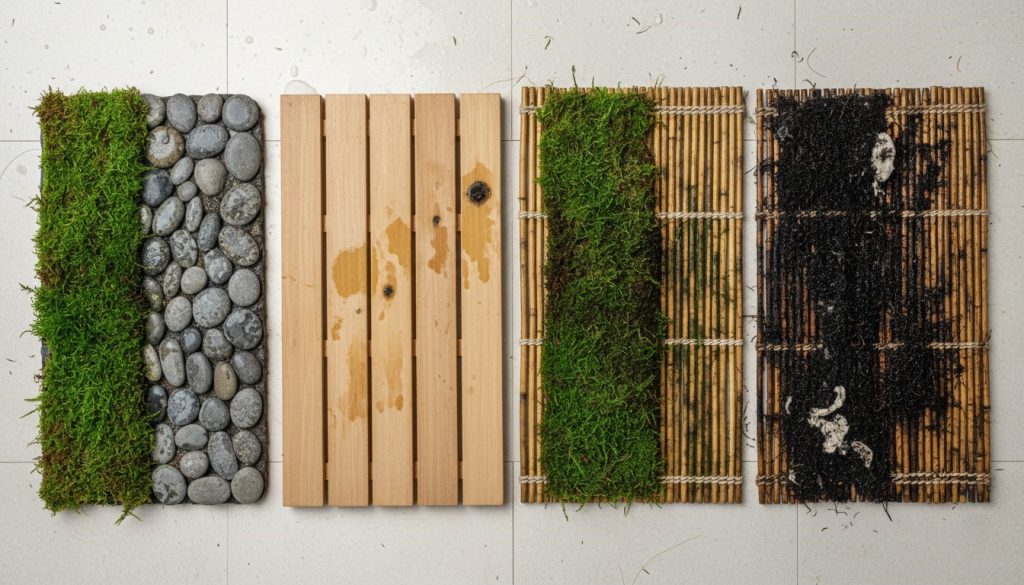
I’ll be honest—I never thought much about bath mats until I slipped getting out of the shower one morning. That split-second of flailing arms and near-disaster made me realize how much we take these humble bathroom essentials for granted. Since then, I’ve become something of a bath mat enthusiast (yes, that’s a thing), testing everything from luxurious hotel-style options to quirky moss varieties. What I’ve learned might just save you from your own bathroom mishap—or at least help you find a mat that doesn’t smell like mildew after two weeks.
Whether you’re furnishing your first apartment, updating a master bath, or trying to make your bathroom safer for aging parents or young children, choosing the right bath mat matters more than you might think. In this guide, I’ll walk you through everything I wish I’d known before buying my first dozen bath mats (yes, I went overboard in my research phase). We’ll cover what actually makes a bath mat good versus just pretty, where to find the best options for your budget, and which specialty types are worth the hype.
Understanding What Makes a Good Bath Mat
After living with various bath mats for the past few years, I’ve developed strong opinions about what separates the keepers from the ones that end up donated after a month. A truly good bath mat isn’t just about looking nice next to your toilet—it needs to perform several jobs simultaneously, and performing them well is surprisingly rare.
The Non-Negotiable Safety Features
The absolute most important thing I’ve learned is this: if your bath mat doesn’t have proper non-slip backing, nothing else matters. I made the mistake of buying a gorgeous Turkish cotton mat on sale once, only to discover it had minimal rubber backing. The first time I stepped on it with wet feet, it shot out from under me like a skateboard. Terrifying.
Look for mats with substantial rubber or silicone backing that covers most of the underside. The backing should feel tacky to the touch, not smooth or plasticky. I’ve found that heavier mats with dense backing tend to stay put better, though they’re admittedly harder to toss in the washing machine.
Water absorption is the second critical factor. A bath mat that can’t absorb water quickly is basically decorative floor art. I once had a microfiber mat that looked absorbent but really just moved water around on its surface. Standing on it felt like standing on a wet sponge that refused to actually soak anything up. The best mats I’ve used can absorb a significant amount of water immediately—you should see wet footprints dry within seconds of stepping off.
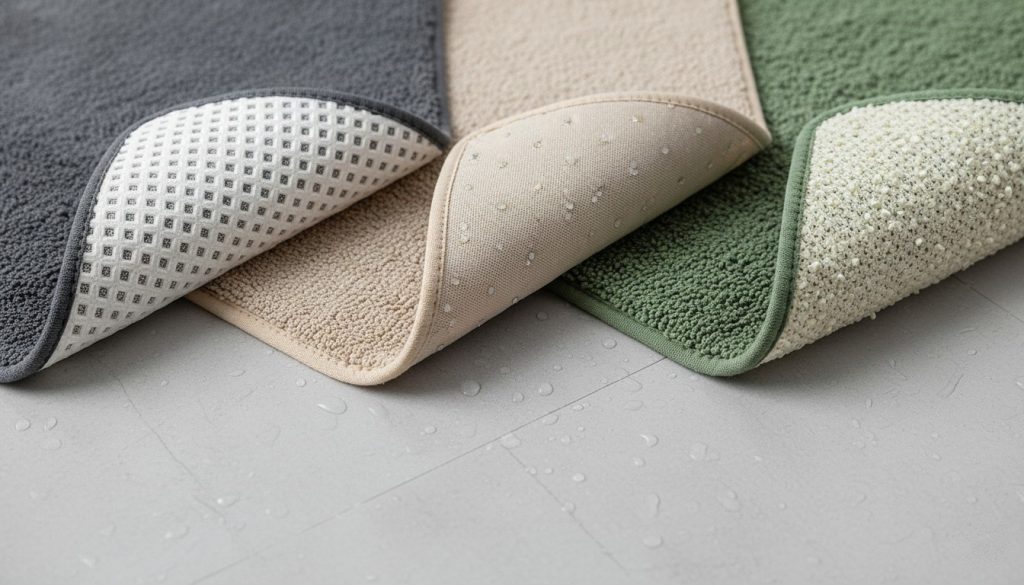
Mold and mildew resistance has been my personal battleground. Bathrooms are humid environments, and some materials are magnets for that musty smell. I’ve learned to prioritize mats that dry quickly between uses and can withstand frequent washing. Cotton mats, while soft, have been the biggest culprits in my experience. They hold moisture and develop that distinctive mildew smell faster than other materials. Stone and teak mats excel here, while memory foam options are hit-or-miss depending on their quality.
The Practical Considerations That Matter Daily
Cleaning ease is something you don’t think about until you’re wrestling a soaking wet mat into your washing machine at 10 PM because it smells funky. Lightweight cotton and microfiber mats are lifesavers here—they wash and dry quickly, and you can easily have backups to rotate. My teak mat, while beautiful, requires occasional oiling and can’t just be thrown in the washer when my toddler has a shampoo spillage incident.
Weight and stability go hand-in-hand. Heavier mats don’t shift around as much, which I appreciate, but they’re also harder to move when you’re cleaning the bathroom floor. I’ve settled on medium-weight options for most areas, reserving the heavier mats for spots where we step out of the shower frequently.
The texture against bare feet is entirely personal, but it matters more than I expected. My husband prefers plush, sink-your-toes-in softness, while I like firmer support. We’ve compromised with a thick cotton terry mat that offers both cushioning and structure. For our guest bathroom, we went with a memory foam option that seems to please everyone.
Choosing the Right Size and Dimensions
This is where I made my first major bath mat mistake. I bought a standard 20″ x 30″ mat for our master bathroom without actually measuring the space. When it arrived, it looked comically small in front of our double vanity, barely covering the area where one person stands. Learning to measure before buying seems obvious, but in the excitement of online shopping, it’s easy to skip.
Understanding Standard Sizes
Small mats, typically around 17″ x 24″, work perfectly for powder rooms or compact apartment bathrooms. I keep one of these in our half-bath, and it’s just right for the limited floor space. These are also great as secondary mats if you want one by the toilet in addition to the shower mat.
Medium mats at 20″ x 30″ are what most people think of as standard, and they’re versatile enough for most average bathrooms. This is the size I use in our kids’ bathroom, positioned right outside their tub. It provides enough coverage for their little feet without overwhelming the small space.
Large mats measuring 21″ x 34″ or bigger are what I wish I’d bought initially for our master bath. These provide substantially more coverage and are essential if you have a walk-in shower or a bathroom where water tends to spread beyond the immediate exit area. The extra inches make a real difference in keeping your floors dry.

I’ve also discovered that runner-style mats, which can stretch to 60″ or longer, are perfect for bathrooms with separate toilet and vanity areas. We installed one along our double vanity, and it’s been a game-changer for keeping water off the floor when both of us are getting ready simultaneously.
Making Smart Space Planning Decisions
Here’s my practical measuring advice: Step out of your shower or tub and notice where you naturally stand. That’s where your mat needs maximum coverage. I put painter’s tape on our bathroom floor to mark out different mat sizes before ordering, which helped me visualize the actual footprint much better than trying to imagine dimensions.
Consider your door swing too. I initially wanted a large mat for our main bathroom but realized it would prevent the door from opening fully. We downsized slightly and positioned it at an angle, which solved the problem while still providing good coverage.
If you have a pedestal sink or a vanity that extends close to the floor, measure the clearance underneath. Some thicker mats won’t slide under toe kicks, which can create an awkward gap or bunching. I learned this when my plush hotel-style mat buckled against our vanity base every single day until I finally switched to a thinner option.
Exploring Popular Material Types
This is where bath mat shopping gets genuinely exciting. I’ve tried almost every material type out there, and each has its own personality and quirks. Some have become permanent fixtures in our home, while others were interesting experiments that didn’t survive long-term testing.
The Natural and Specialty Materials
Living Moss Bath Mats
I’ll admit, I bought a moss bath mat mostly because it seemed like a fun conversation piece. What surprised me was how much I actually enjoyed using it. These mats are made with preserved or living moss (mine is the preserved variety) set in a foam base. The sensation underfoot is unique—soft but firm, slightly cool, and oddly soothing.
The catch with moss mats is that they require specific conditions to thrive. They need humidity to stay soft, which sounds perfect for a bathroom, right? Well, yes and no. They need moisture but not constant soaking. My moss mat started deteriorating when placed directly outside our shower where it got drenched twice daily. Moving it to a spot that got ambient bathroom humidity but not direct water spray extended its life considerably.
For maintenance, I mist mine lightly every few days if the bathroom feels dry, and I prop it up to air out completely once a week. It’s more high-maintenance than a standard mat, but as a statement piece in our guest bathroom, it works beautifully. Just know that these aren’t throw-it-in-the-washer-and-forget-it options.
Stone Bath Mats
My diatomaceous earth stone mat was a revelation. These mats are made from highly absorbent sedimentary rock, and they dry almost instantly. I mean, you can watch the water evaporate from your footprints in real-time. It’s oddly satisfying.

The stone surface is smooth but not slippery, and it stays cool to the touch, which feels amazing in summer but a bit shocking on winter mornings. At nearly 10 pounds, this mat absolutely doesn’t move—it’s like standing on a small piece of countertop. The weight was intimidating at first, but now I appreciate the stability.
Here’s the thing about stone mats: they can crack if dropped, and you can’t throw them in the wash. Cleaning involves wiping them down with a damp cloth and occasionally using fine sandpaper if they develop stains. I sand mine lightly every few months, which keeps the surface fresh and absorbent. Also, placement matters—I wouldn’t recommend these for second-floor bathrooms if you live in an older home with questionable floor support.
Teak Bath Mats
Our teak mat lives in the master bathroom, and it’s probably my favorite for aesthetics. Teak is naturally water-resistant and has a spa-like quality that makes the bathroom feel more expensive than it is. The slatted design lets water drain through immediately, so you’re never standing on a wet surface.
The downside is maintenance. Teak needs occasional oiling to prevent it from drying out and turning gray. I oil ours about once a month with teak oil (not furniture polish—learned that the hard way when our mat got sticky), which takes maybe five minutes. Without regular care, teak will still function fine but won’t look as rich and warm.
Teak mats work best over tile or other hard flooring. We tried one briefly on bathroom carpet, and it created weird pressure points that damaged the carpet pile. They’re also not ideal if you have small children who might pinch fingers in the slats (though this hasn’t been an issue with our four-year-old).
Hotel-Style Plush Mats
When I say hotel-style, I mean those thick, luxuriously soft cotton mats that feel like you’re stepping onto a cloud. I bought one after staying at a nice hotel and falling in love with their bathroom setup. These mats are typically made from high-quality Egyptian or Turkish cotton with a dense, absorbent pile.
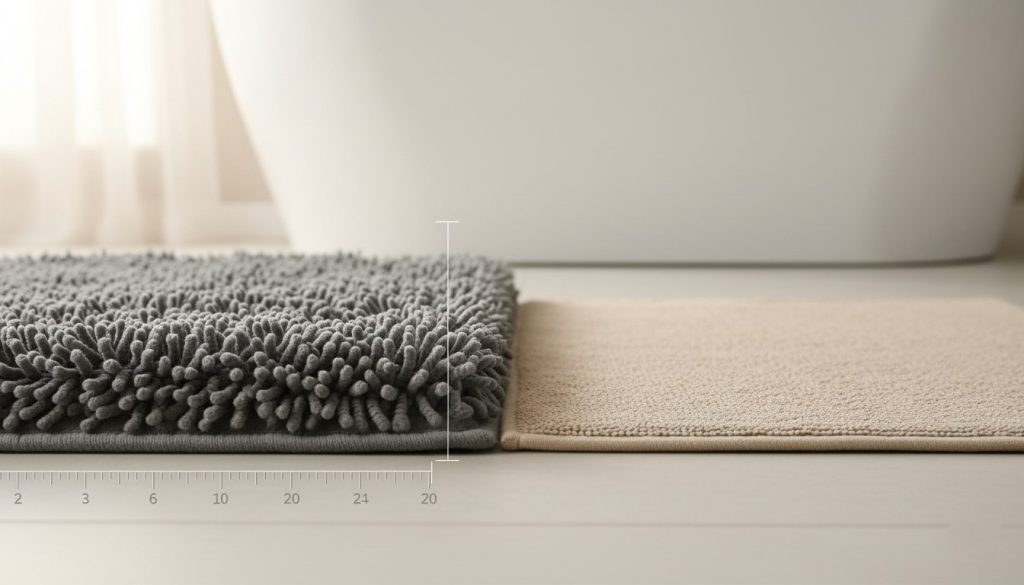
The experience of using a hotel-style mat is genuinely lovely. They’re soft enough to stand on while you dry off without feeling rushed, and they absorb water beautifully. The thickness provides cushioning that’s especially nice if you’re spending time at the sink doing skincare or styling hair.
The trade-off is weight and drying time. These mats are heavy when dry and absolutely massive when wet. Washing requires a large-capacity machine, and they take forever to dry—we’re talking potentially two dryer cycles. I bought two so I can rotate them, which has been essential. They also require more frequent washing than other types because that plush pile holds onto moisture, making them prone to mildew if not cared for properly.
The Everyday Traditional Options
Memory foam mats have been hit-or-miss in my experience. The good ones contour to your feet nicely and provide excellent cushioning. The cheap ones compress quickly and never fully bounce back, leaving permanent foot impressions. I’ve found that spending at least $25-30 on a memory foam mat is necessary to get one that lasts.
Microfiber mats are practical workhorses. They’re lightweight, wash easily, dry quickly, and come in countless colors and patterns. We have several as backups and for lower-traffic bathrooms. They don’t feel as luxurious as cotton, but they’re reliable and low-maintenance.
Cotton terry is the classic choice for good reason. It’s soft, absorbent, and familiar. Most of our everyday mats are cotton terry because they strike a good balance between comfort and practicality. They wash well and last for years if you buy decent quality.
Chenille mats have that fuzzy, shaggy texture that some people love. I personally find them harder to keep clean—the long fibers seem to trap more hair and debris—but they’re undeniably cozy underfoot.
Specialized Recommendations by User Needs
Through helping family members and friends shop for bath mats, I’ve learned that different life situations require different solutions. What works for my relatively able-bodied household isn’t necessarily what works for my parents or my sister with a newborn.
Finding the Right Fit for Textured Tubs
My in-laws have one of those older tubs with a textured, slip-resistant bottom, and they struggled for years to find bath mats that would stay put. The texture prevents standard rubber backing from making full contact with the floor, causing the mat to shift unpredictably.
After some trial and error, we discovered that mats with extra-thick, tacky silicone backing work much better than standard rubber. The silicone conforms to the floor texture and creates suction. We also found success with mats that have suction cups on the corners in addition to full backing. These grab onto the floor more aggressively.
Heavier mats also help tremendously in this situation. The added weight compensates for reduced grip, keeping the mat more stable. My in-laws now use a thick memory foam mat with enhanced silicone backing, and it’s stayed in place reliably for over a year.
Senior-Friendly Features That Actually Help
When we were updating my parents’ bathroom, safety became the absolute top priority. I researched extensively and visited their house multiple times to understand exactly what they needed. The results might be useful if you’re in a similar situation.
Low-profile edges are crucial. Many plush mats have thick, raised borders that can catch on feet or walkers. We chose mats with tapered edges that create a gentle ramp from floor to mat surface. This small detail makes a significant difference for someone with mobility challenges.
Maximum grip became non-negotiable. We selected mats with the most aggressive rubber backing we could find, and we still added grip tape underneath for extra security. It might seem like overkill, but peace of mind is worth it.

The mats we chose are also bright white against their gray tile floor. High contrast helps with depth perception, which can be challenging for older eyes. My mom initially wanted something decorative, but we convinced her that visibility and safety trumped aesthetics.
We also opted for multiple smaller mats instead of one large one. There’s a mat outside the shower, one at the sink, and one by the toilet. Each mat is easier to wash than a single large one, and if one becomes a trip hazard, it’s easy to remove temporarily without leaving the whole floor bare.
Baby and Toddler Bathroom Solutions
Having small children completely changed my bath mat perspective. Suddenly I was looking at features I’d never considered before, like whether the materials were non-toxic and whether the mat could survive daily splashing and the occasional potty training accident.
For the kids’ bathroom, I chose a simple cotton terry mat with certified non-toxic dyes. Young kids put everything in their mouths, and while I couldn’t prevent them from licking the bath mat (which happened exactly once before my daughter decided it tasted terrible), I could at least ensure the materials were safe.
Extra cushioning matters more than I anticipated. I spend a lot of time kneeling beside the tub during bath time, and a thin mat made my knees ache. A thicker mat with good cushioning makes those 20-minute bath sessions much more comfortable. It also provides padding for the inevitable slips and tumbles that come with teaching toddlers to bathe themselves.
Easy-clean surfaces are absolutely essential. Our kids’ bathroom mat goes in the wash weekly, sometimes more often. I chose materials that can handle frequent hot-water washing without falling apart. Waterproof or water-resistant backing is also important—you don’t want moisture seeping through to create mildew underneath.
The playful designs have actually been useful for encouraging bathroom independence. Our mat has colorful sea creatures on it, and my son stands on the “octopus spot” to brush his teeth. These little games make routines more fun, and bath mats are an easy place to add personality to a kid’s bathroom without major expense or commitment.
Budget-Friendly Shopping Strategies
I’ve bought bath mats at every price point, from $8 basic options at discount stores to $60 luxury mats from specialty retailers. Here’s what I’ve learned about getting the best value regardless of your budget.
Understanding Price Brackets and What They Mean
In the $10-15 range, you’re generally getting basic functionality. These mats will absorb water and provide some non-slip protection, but don’t expect them to last more than a year or two with regular use. I keep several inexpensive mats as backups and for low-traffic bathrooms. They’re perfect for guest rooms that get used occasionally or for rental properties where you need something functional but don’t want to invest heavily.
The $15-30 range is the sweet spot for everyday mats that balance quality and affordability. Most of my daily-use mats fall into this category. They have better construction, more durable materials, and improved non-slip backing. With proper care, these mats easily last three to five years.
Above $30, you’re paying for premium materials, superior craftsmanship, or specialty features. My hotel-style cotton mat cost $45, and while that seemed expensive initially, it’s outlasted three cheaper mats and still looks new. Sometimes the upfront investment is worth it, particularly for high-traffic areas or if you want specific features like extra thickness or luxury materials.
Knowing When to Invest More Versus Save
I’ve developed a rule of thumb: invest more in mats for your primary bathroom where you use them multiple times daily. These get the most wear and need to perform reliably. Save on mats for guest bathrooms, powder rooms, or spaces that see limited use.
Also consider your lifestyle and household. With two young kids and all the spills, splashes, and general chaos they create, I’ve actually found more value in buying mid-range mats that I can replace guilt-free when they get destroyed. If you live alone or with one other adult, a premium mat will probably provide more satisfaction and better longevity.
Specialty mats like stone or teak are worth the higher price if you’re drawn to them. These aren’t just functional items—they genuinely enhance your bathroom experience and often last much longer than fabric alternatives. My teak mat has been going strong for three years and shows no signs of wearing out.
Finding Sales and Deals
Bath mats go on sale predictably. January white sales are legendary for a reason—retailers deeply discount bath and bedding items to clear inventory after the holidays. I’ve scored hotel-quality mats for half price during these sales. Setting a reminder on my phone for early January has become part of my annual shopping routine.
Black Friday and Cyber Monday offer legitimate discounts on bath mats, particularly online. I bought three backup mats last November at 40% off, which stocked our linen closet for the year. End-of-season clearances also yield good deals—colorful summer patterns get marked down in fall, and winter whites drop in price come spring.
Multi-pack deals can offer excellent value if you need several mats or want backups. I recently bought a three-pack of microfiber mats for less than what two would have cost separately. Just make sure you actually want three of the same mat—I’ve made the mistake of buying sets only to realize I didn’t like the style as much as I thought.
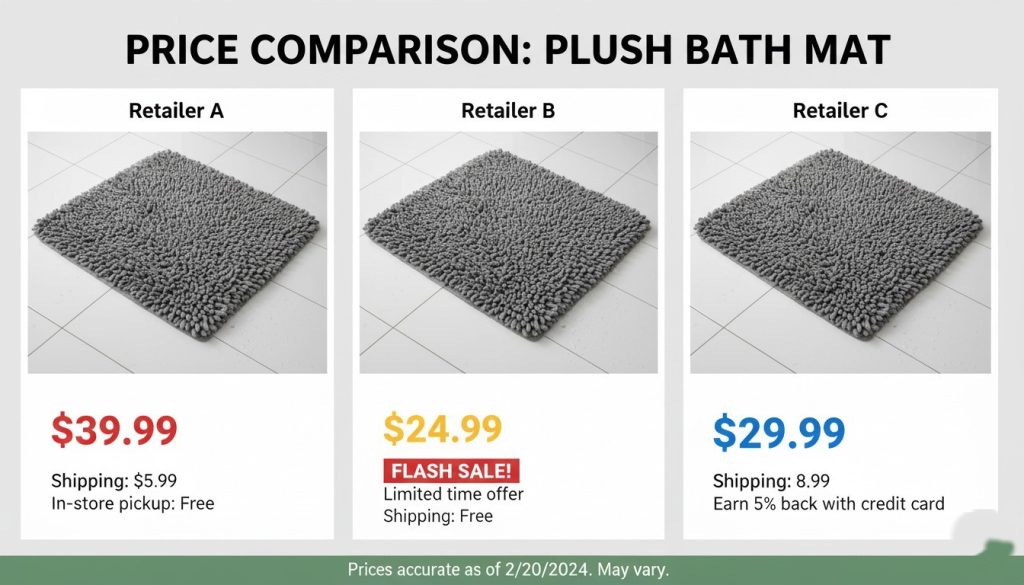
Signing up for email lists from home goods stores provides access to exclusive coupons and early sale notifications. Bed Bath & Beyond’s famous 20% off coupons apply to bath mats, turning a $30 mat into a $24 purchase. Small savings add up, especially if you’re furnishing multiple bathrooms.
Where to Buy Bath Mats
After years of shopping both online and in physical stores, I’ve developed preferences for where to buy based on what I’m looking for. Each shopping channel has distinct advantages, and knowing where to look for specific types of mats saves time and often money.
Shopping Online for Selection and Convenience
Amazon has become my go-to for quick needs and research. The selection is enormous, covering everything from $10 basics to $100 specialty mats. What I value most is the review system—I read through both positive and critical reviews before buying to understand real-world performance. The photos that customers upload are especially helpful for seeing how mats look in actual bathrooms rather than styled marketing shots.
Prime shipping means I can order a mat on Monday and have it by Wednesday, which proved crucial when our primary bath mat developed a weird smell and needed immediate replacement. The easy returns also reduce risk when trying new styles. I’ve returned three mats over the years, each time without hassle.
Wayfair has impressed me for bathroom shopping specifically. Their visual search tools let you upload a photo of your bathroom and find mats that match your decor. I’ve used this feature to ensure color coordination before buying. Their “view in your room” augmented reality feature helps visualize size, though it’s not perfectly accurate—still, it’s better than guessing.
Overstock has been my source for deals on higher-end mats. I found a $50 Egyptian cotton mat for $28 during one of their sales. The selection isn’t as vast as Amazon, but the discount pricing on quality items makes it worth checking regularly. Shipping can be slower, so this isn’t my choice for urgent needs.
Target.com combines reasonable prices with style variety. I appreciate their same-day delivery option for last-minute guests or unexpected needs. The ability to check in-store availability before ordering online has saved me trips when items are out of stock. Their in-house brands, particularly Threshold and Project 62, offer good quality at accessible prices.
The Company Store specializes in bath and bedding, and their bath mat selection reflects that focus. The quality is consistently high, though prices run above average. I bought a luxury mat from them as a gift, and the recipient still raves about it two years later. They frequently run sales that make the premium pricing more reasonable.
The Benefits of Brick-and-Mortar Shopping
Despite my online shopping habits, I still visit physical stores regularly for bath mats. There’s no substitute for touching materials and seeing colors in person, particularly for items you’ll interact with daily.
Target stores let me feel textures and judge actual size before buying. I’ve caught several mats that looked plush online but felt thin and scratchy in person. Being able to check the backing quality—how tacky it feels, how much coverage it provides—has saved me from multiple disappointing purchases. Their return policy is straightforward if I change my mind at home.
HomeGoods and TJ Maxx are treasure hunts that occasionally yield amazing finds. I’ve scored designer mats at 60-70% off retail, including a gorgeous Turkish cotton mat that would have cost $55 elsewhere for just $19.99. The catch is inconsistent inventory—you can’t rely on finding specific items, but browsing every few weeks sometimes surfaces gems. I found my teak mat at HomeGoods for half of what similar options cost online.

Bed Bath & Beyond stores (where still operating) offer extensive selection with the convenience of using coupons in person. I like being able to see multiple styles from different brands side by side. The staff has been helpful when I’ve had questions about specific features or care instructions. The downside is higher base prices compared to discount retailers, though coupons help offset this.
Walmart serves as my emergency backup when I need something immediately and affordably. The selection leans toward basic options, but you can walk out with a functional mat for under $15. Quality varies significantly, so I stick to brands I recognize when shopping there. I’ve bought several Mainstays-brand mats that, while not luxurious, have held up adequately for the price.
Home Depot and Lowe’s aren’t obvious bath mat destinations, but they stock functional options, particularly rubber and commercial-grade mats. I bought a heavy-duty rubber mat from Home Depot for our pool bathroom, and it’s withstood three years of constant traffic and moisture. These stores are good for prioritizing function over style.
Weighing Online Versus In-Store Advantages
Shopping online gives me access to far more options than any single store stocks. I can compare prices across multiple retailers in minutes, read extensive reviews, and shop at midnight in my pajamas. The convenience factor is huge when juggling work and kids—I don’t need to carve out time for a shopping trip.
In-store shopping lets me assess quality firsthand. Colors look different on various screens, and material descriptions don’t always convey actual texture. I’ve learned that “soft” means different things to different manufacturers. Seeing and touching mats eliminates surprises. I also get immediate gratification—no waiting for shipping or worrying about package theft.
My current strategy combines both: I research extensively online, narrow down options, then visit stores to examine leading candidates in person when possible. If a store carries exactly what I want, I buy it there. If not, I order online with confidence because I’ve done my homework.
Top Picks Across Categories
After living with numerous bath mats and helping friends and family make their own selections, I’ve developed strong opinions about which mats excel in different categories. These recommendations come from real-world testing, not just marketing claims.
Overall Performance Leaders
For best overall value, I consistently recommend the cotton terry mats in the $20-25 range from Target’s Threshold line. They’re not the cheapest or the fanciest, but they perform reliably across all the important metrics. Good absorption, decent non-slip backing, easy to wash, and they last. I’ve had mine for three years with weekly washing, and they’re still going strong.
If budget isn’t a constraint and you want luxury, invest in a high-quality Egyptian cotton hotel-style mat from a reputable brand. The Company Store and Parachute both make excellent options. These mats transform your daily bathroom routine into something more spa-like. The $45-60 price point feels steep until you experience the difference in quality and longevity.
For eco-conscious buyers, I recommend organic cotton mats certified by GOTS (Global Organic Textile Standard). Coyuchi and Boll & Branch make excellent versions. They cost more than conventional cotton mats but avoid pesticides and harmful dyes. Mine has held up beautifully and feels good in multiple ways.
The most versatile style I’ve found is a simple solid color in a neutral tone with a subtle texture. These mats work in any bathroom, never look dated, and are easy to coordinate with changing decor. Avoid trendy patterns unless you’re prepared to update when trends shift—I learned this after buying a geometric print mat that looked dated within two years.
Category-Specific Winners
For quick-drying performance, my diatomaceous earth stone mat wins hands down. Nothing else comes close to the instant drying. If you hate soggy mats or have multiple people using the same bathroom in quick succession, stone is worth considering despite the higher price and maintenance requirements.
The plush experience champion is my hotel-style Turkish cotton mat. Stepping onto it feels indulgent every single time. It’s thick, soft, and substantial in a way that budget mats simply can’t match. This is a “buy once, cry once” situation—the upfront cost is high, but the years of daily luxury justify it.
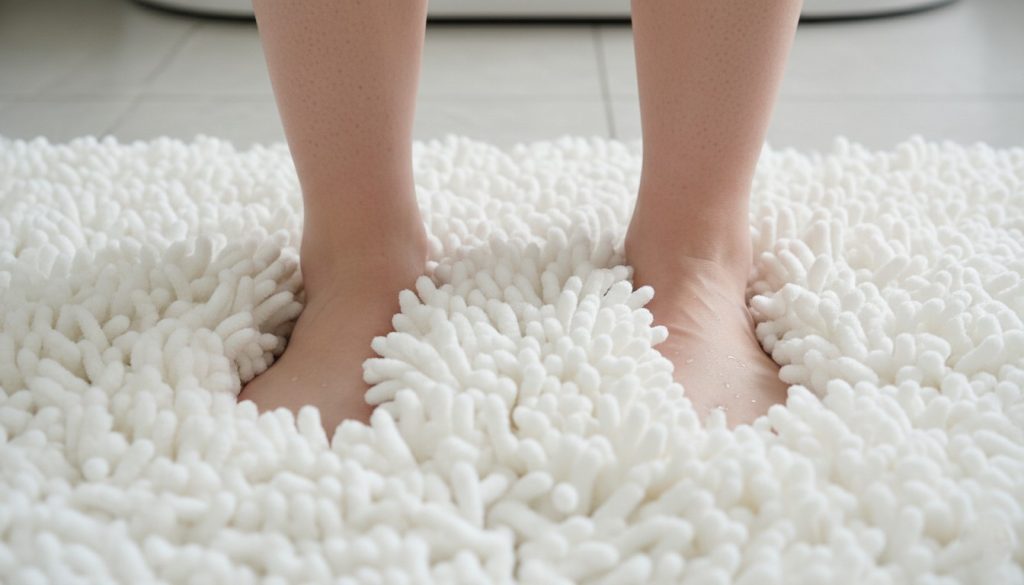
Most durable construction goes to my teak mat. It’s been in daily use for three years with minimal wear. Unlike fabric mats that eventually pill, flatten, or develop thin spots, teak maintains its appearance and function indefinitely with basic care. If you’re furnishing a forever home and want to buy bath mats once, teak is the move.
Easiest to clean is any basic microfiber mat. These lightweight mats wash quickly, dry fast, and don’t require special care. I can throw one in with a regular laundry load without worrying about overwhelming the washer. For households with kids, pets, or frequent guests, the low-maintenance aspect is genuinely valuable.
Care and Maintenance Tips
I’ve learned most of these lessons the hard way—through mildewed mats, prematurely worn backing, and colors that faded after a few washes. Proper care extends mat life significantly and keeps them performing well.
Washing and Drying Best Practices
Most fabric mats should be washed weekly in my experience, possibly more often in humid climates or with heavy use. I wash ours every Sunday as part of my regular laundry routine. Waiting longer than two weeks almost always results in that musty smell that’s hard to eliminate once it sets in.
Hot water works best for killing bacteria and removing soap scum buildup. I use warm water for colored mats to preserve brightness and hot water for white mats. Adding a half cup of white vinegar to the rinse cycle helps remove detergent residue and odors without harsh chemicals. This trick has saved several mats I thought were beyond redemption.
Avoid fabric softener completely. It coats fibers and reduces absorbency—your mat will repel water instead of soaking it up. I learned this after wondering why my mat suddenly stopped working well, not realizing fabric softener was the culprit. It took several washes with just detergent to restore proper absorbency.
Tumble dry on low to medium heat for most mats. High heat can damage rubber backing, causing it to crack and peel. I’ve ruined the backing on two mats by using high heat in a rush to dry them. The patience to use lower heat settings pays off in extended mat life. Some specialty mats recommend air drying—always check care labels.
Storage and Daily Maintenance
The biggest maintenance habit I’ve adopted is hanging mats to dry between uses. I installed simple hooks on the bathroom wall, and after morning showers, I hang our primary mat for a few hours. This single change eliminated our mildew problems completely. The mat dries thoroughly and gets air circulation, preventing moisture buildup.
For bathrooms without hanging space, I prop mats against the bathtub edge or over the shower door. Even this minimal airflow helps significantly. Never leave a wet mat bunched on the floor—that’s asking for mildew and bacteria growth.
I shake out my mats outdoors weekly to remove accumulated hair, dust, and debris. This simple maintenance step keeps them fresher between washings. For stone and teak mats that can’t be washed, this becomes even more important.
Knowing When to Replace
Most fabric mats need replacement every two to three years with regular use and proper care. Signs that it’s time include persistent odors despite washing, visible thinning or holes, rubber backing that’s cracking or peeling, and significantly reduced absorbency.
I keep backup mats so I’m never caught without one when a primary mat needs replacing. Having a spare also allows me to rotate mats, which extends the life of both by reducing the wear on each.
Specialty mats like stone and teak last much longer—potentially indefinitely with proper care. Stone mats might eventually develop stains that can’t be sanded out, but this takes years. Teak mats might crack if allowed to dry out completely, but regular oiling prevents this.
Conclusion
Looking back at my bath mat journey—from that scary slip to becoming someone who genuinely cares about bathroom textiles—I’ve realized that these humble items deserve more attention than most of us give them. A good bath mat contributes to your safety, comfort, and even your bathroom’s aesthetic. The right choice makes every post-shower moment a little better, while the wrong one becomes a daily annoyance or, worse, a safety hazard.
The key is matching your mat choice to your specific needs rather than just grabbing whatever’s on sale. Consider who uses the bathroom, how often, and what matters most—safety features for elderly users, easy cleaning for families with children, luxury feel for your personal retreat, or budget-friendliness for a rental property. No single mat is perfect for everyone, but there’s definitely a perfect mat for your situation.
Start by assessing your priorities: Do you need maximum absorbency or prefer quick-drying? Is non-slip performance critical, or are aesthetics your main concern? How much maintenance are you willing to do? Your answers to these questions will guide you toward the right material and style.
Don’t be afraid to invest in quality for your main bathroom. The daily use justifies spending more for something that performs better and lasts longer. At the same time, there’s no shame in budget options for guest bathrooms or low-traffic spaces—save your money for where it matters most.
Remember that you can always try different options. Bath mats are relatively inexpensive compared to other home updates, and returning something that doesn’t work is usually straightforward. I’ve returned mats that looked great online but felt wrong in person, and I’ve switched out mats that didn’t perform as expected. Finding your perfect bath mat might take a couple of tries, and that’s completely normal.
Take the time to measure your space, read reviews from actual users, and consider touching mats in person before buying if possible. These small efforts upfront save you from disappointment and the hassle of returns later. Your bathroom—and your feet—will thank you.
